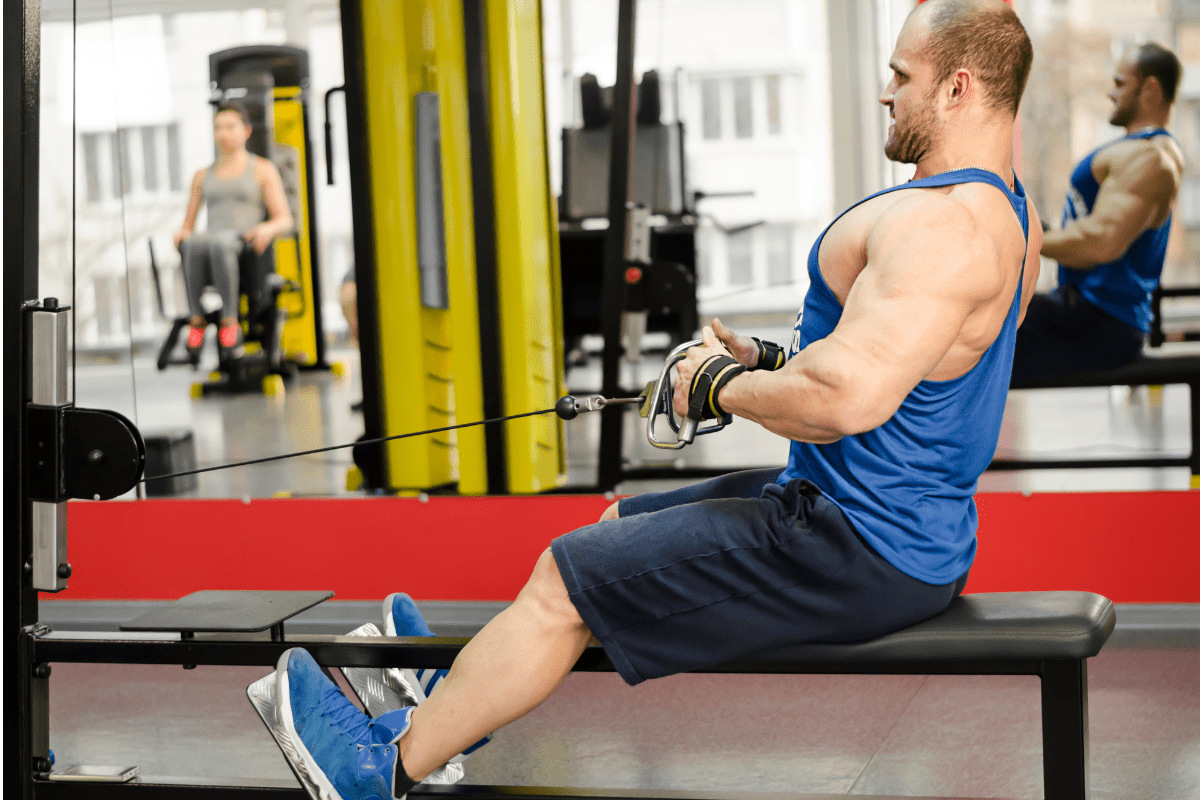10 Best Seated Cable Row Alternatives To Build Mass
Seated Cable Rows are a strength training exercise that targets the muscles of the back, including the lats, rhomboids, and rear deltoids. This exercise is performed using a cable pulley machine that can be found in many commercial gyms.
Seated Cable Rows can be a great exercise for building strength and hypertrophy. And, even though the chest isn’t supported, Seated Rows do place less stress on the low back compared to other rowing exercises like Barbell Bent Rows.
As good as the Seated Cable Row is though, sometimes you may need an alternative exercise for it. The obvious reason being you don’t have a cable machine, but maybe you just want to add some variety to your workout.
Whatever the reason, you’re in the right place. I’m about to share with you 10 of my favorite Seated Cable Row alternatives and detailed instructions on how to do each one.
This article contains affiliate links. If you buy something using these links I may earn a commission. Thanks.
Seated Cable Row Alternatives
I’ve tried to include as much variation in this list of alternatives as possible. There are exercises that use a variety of equipment, from barbells to dumbbells and even a TRX Strap. There are also exercises that are beginner-friendly as well as movements that will challenge even advanced lifters.
My goal is that no matter what equipment you have access to and regardless of your level of experience, you’ll find at least one exercise that will be a good fit for you and your situation.
T Bar Row
If you have access to a T Bar Row machine, it is one of the best Seated Cable Row alternatives that you’re going to find.
It’s another machine that is going to take care of most of the movement path and allow you to focus on pulling big weight.
How To
- Set yourself up on the T-Bar Row Machine*
- Feet should be flat on the platform and the chest supported on the pad.
- Grab the handles, brace the core and unrack the bar.
- Make sure your posture is good and then row the bar toward your chest.
- Lower back down under control and repeat until all reps are complete.
- Once all reps are down, re-rack the bar into its rack.
Coaching Points
*Exactly how you set yourself up will vary dependent upon the machine. Not all T-Bar Row Machines are exactly the same.
By far the biggest mistake I see with T-Bar Rows is athletes I coach think that because there is a pad to support their chest, they don’t need to have good posture.
This is wrong. You should still have the same posture – back and core engaged – as you would if you didn’t have a pad supporting you.
Bent Over Barbell Row
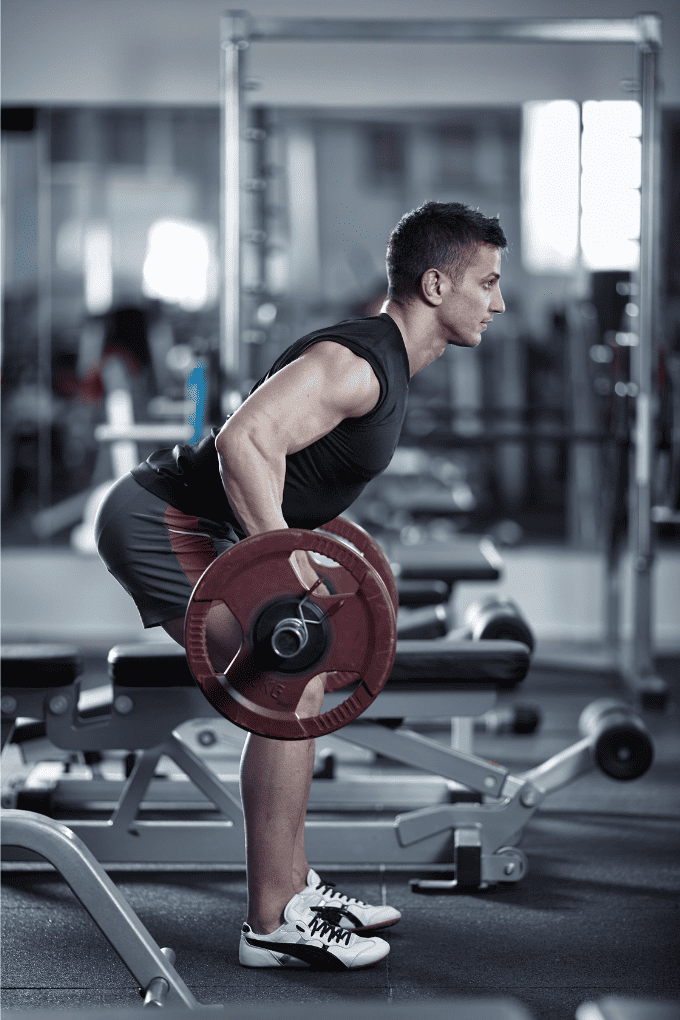
If you don’t have access to any machines, then the Bent Over Barbell Row is going to be your best bet for developing strength and adding mass.
You do have to be very mindful with your technique on the Barbell Row.
Make sure to maintain a flat back and a braced core while you row from that bent-over position.
Step-by-Step Instruction
- Approach the barbell and take a shoulder-width stance. Your shins should be almost touching the barbell.
- Hinge at the waist and bend the knee until you can grab the barbell. Use a pronated grip (Knuckles facing the floor). I will talk later about the supinated grip (palms up) in this movement.
- Always keep a flat back, and a neutral spine, and keep your eyes focused slightly down about 1 foot in front of you.
- Take a deep breath, brace the abdomen, and pull the bar in until it makes contact right about the belly button.
- Pause for about 1 second. Squeeze the shoulder blades and lock in the rep.
- Slowly return the barbell back to the starting position (weights about 1-2 inches off the ground).
Coaching Points
The initial setup and stance for Barbell Bent Over Rows should be specific to the lifter’s deadlifting and/or Olympic lifting goals. Having identical setups and grips will be great for the lifts to carry over to the compound movements.
Dumbbell One Arm Row
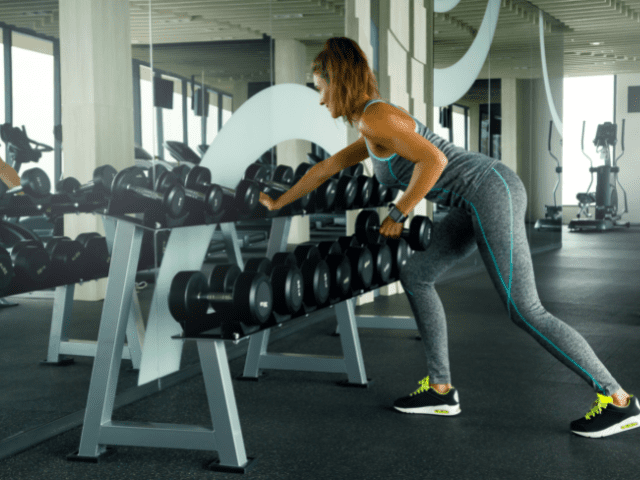
Have dumbbells to work with?
The One Arm Dumbbell Row is another excellent horizontal row that can make a great Seated Cable Row alternative.
Being able to brace with the off-hand takes some of the strain off the low back and you can still row some pretty serious weight.
A bench is helpful, but not totally necessary. Bracing one arm against the rack (as pictured above) or even on your leg can work as well.
Step-by-Step Instructions
- Grab a dumbbell and a bench*.
- Place the dumbbell next to the bench and set yourself up.
- If rowing with the right arm, place the left knee and left hand on the bench. Keep the right foot flat on the ground.
- Make sure the back is flat (neutral) to slightly arched.
- Brace the core and pick the dumbbell up.
- Row the dumbbell up, keeping the elbow close to the body as the dumbbell raises.
- Squeeze the back at the top of the rep and then lower the dumbbell down until the arm is fully extended.
- Repeat for the designated number of reps and then switch sides.
*One Arm Rows do not have to be done with one knee on a bench. You can keep both feet flat on the ground and lean forward and brace yourself with your off-hand on something sturdy. You can even lean your off forearm on your leg for support if necessary.
Coaching Points
The most common mistake I see my athletes make when doing One Arm Rows is not maintaining a flat back.
The back should stay engaged and slightly arched – similar to the starting position of a Power Clean. Do not let the back round as this can cause unnecessary stress on the spine.
Inverted Rows
Inverted Rows can often be overlooked as ‘just a bodyweight exercise’, but don’t fall for that trap.
Inverted Rows are one of the best Seated Cable Row alternatives that can build strength and they come with a ton of variety.
You can bend your knees to make them easier and more beginner-friendly. Or, you can elevate your feet or even use a weight vest to up the difficulty.
Step-by-Step Instructions
- Start by placing a bar on the rack about waist height.
- The higher the bar is placed, the easier the rows will be. The lower the bar is placed, the harder the rows will be. (Just make sure to leave yourself enough room to fully extend your arms at the bottom of the rep)
- Set the bar on either the J-Hooks or the Safety Bars
- Lay down underneath the bar.
- Grab the bar with an overhand grip, brace the core and make sure your body is fully extended – including your legs.
- You should be positioned to where when you pull yourself up towards the bar, the bar touches the same spot on the chest as it would for bench press. Slide up or down to adjust accordingly.
- Now, keeping your body in a straight line, pull your chest up to the bar and lower back down until your arms are fully extended.
- Repeat until all reps are completed.
Coaching Points
Athletes I coach love to either pull their faces to the bar or even raise their chin up and over the bar like a pull-up. These are both wrong.
You should think of the Inverted Row as a reverse bench press. Keep your head back, chest out and pull your chest directly to the bar. Pull the shoulder blades down and back at the top of the rep and squeeze the back.
TRX Rows

TRX Rows, or Ring Rows if you have a set of gym rings, are very similar to Inverted Rows. It’s primarily a bodyweight exercise where you can increase or decrease the difficulty of the exercise by changing the angle in which you work.
If you take a TRX strap with you on road trips, this should be your go-to alternate for Barbell Bent Rows. (If you don’t already have a TRX Strap, you can pick one up from Amazon here.)
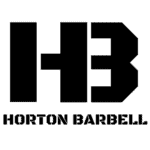
Tired of coming up with your own workouts? But don’t want to pay an arm and a leg?
I post workouts 5 days a week right here. (Did I mention they’re free?)
Landmine Row

Landmine Rows are very similar to T-Bar Rows – both of which make great Seated Cable Row alternatives.
Like Bent Over Barbell Rows, this movement places a lot of emphasis on the low back to maintain good posture while rowing. Make sure to keep a flat back and a braced core when doing Landmine Rows.
Step-by-Step Instructions
- Setup your landmine attachment.
- Load the open end of the barbell with the desired amount of plates.
- Grab the barbell toward the plate side using your hands or a cable attachment.
- Use a shoulder-width stance, bend the knees, braced core and flat back.
- Pull the plates up off the floor and begin rowing by pulling the bar toward you.
- Most often you will be able to row until the weight plates touch your chest.
- Control the eccentric portion of the lift back to arms extended and repeat.
Coaching Points
Using a cable attachment for Landmine Rows has its pro and cons. It makes the setup more comfortable and convenient to row, but if you place metal straight on your barbell it can scratch it up. Keep that in mind if you’re planning on using one.
Hammer Machine Iso Rows
Ah, the Seated Hammer Row machine. I have zero machines in my garage gym, but the one machine I would buy if I ever find one at a decent price is a Hammer Iso Row Machine. It is hands down my favorite.
How To
- Start by either standing or seated* with your chest against the support pad.
- Reach forward, grab the handles and then brace your core and set your posture.
- Row the handles toward your chest, quickly pause at full contraction and then slowly lower back to arm’s length.
- Repeat until all reps are completed.
Coaching Points
If doing rows seated, adjust the seat to the proper height so your chest is against the pad and you can row comfortably. For taller lifters, you can also do Hammer Seated Rows standing as well. Lower the seat out of the way and find a comfortable position for your feet to stand.
The rowing motion shouldn’t change whether standing or seated.
By far the biggest mistake I see with Hammer Rows is athletes I coach think that because there is a pad to support their chest, they don’t need to have good posture. This is wrong. You should still have the same posture – back and core engaged – as you would if you didn’t have a pad supporting you.
Close Grip Lat Pulldowns

Not all cable machines have the ability to be set up as a low row for Seated Cable Row.
If your Lat Pulldown machine is fixed at the top, then find a narrow grip handle attachment and try Close Grip Lat Pulldowns.
Pro Tip: If you lean back a little further than you normally would for a Lat Pulldown, then the exercise comes really close to mimicking an actual Seated Cable Row.
Step-by-Step Instructions
- Depending on the machine or attachment that you’re using the setup may be a bit different.
- Regardless of the setup, try to position your torso predominantly upright with a very slight lean back.
- Now, pull the handle down to your chest, squeezing the lats hard at the bottom.
- After a quick pause at the bottom of the rep, slowly bring the bar back up to the starting position.
Coaching Points
Stay in control of the weight. By far the most common mistake I see lifters make is using way too much weight and rocking and swinging all over the place to try to get the weight to move.
READ MORE –> Seated Cable Rows vs Lat Pulldowns
Renegade Rows

If I’m being honest this is the row that will make me lose sleep at night.
The Renegade Row is a true total-body exercise that will challenge your back, biceps, shoulders and core and will even get your heartrate going on a high rep set.
If you want a Seated Cable Row alternative that is a bit outside the box and a completely different kind of challenge, Renegade Row is a great option.
Instructions
- Grab one dumbbell in each hand and assume a pushup position with feet about shoulder width apart.
- Make sure the core is braced and row one dumbbell up.
- Lower the dumbbell under control and return to the starting pushup position.
- Alternate rowing each arm until all reps are completed.
Coaching Points
Try to limit rotating the torso as much as possible when doing Renegade Rows. It’s natural to want to open the torso toward the side of the arm you’re rowing with – try to fight against this and stay as square as possible.
The wider your feet, the easier it is to stay balanced while you perform the movement. Try to keep feet about shoulder-width apart.
Chin-Ups
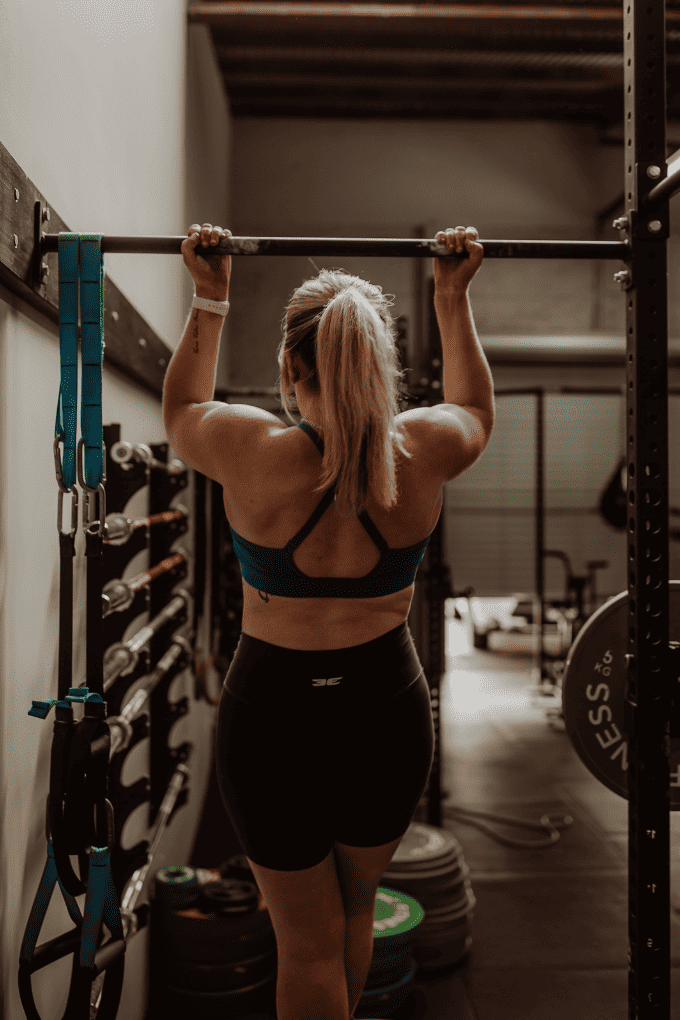
It’s hard for me to have a list of alternatives for a back exercise and not include either Pull-ups or Chin-ups.
In my opinion, they’re two of the absolute best exercises for developing a strong back.
I chose Chin-ups over Pull-ups here because the narrower underhand grip lends itself to being a better Seated Cable Row alternative.
Step-by-Step Instruction
- Approach the pull-up bar and grab the bar with a supinated grip (palms facing toward you).
- Use a bench to get to the bar if it is too high.
- Squeeze the bar and engage the core muscles and do not cross your legs.
- Engage the upper back and pull up until your chin is over the bar.
- Pause for 1 second with your chin over the bar.
- Slowly lower yourself back to the starting position.
- Repeat until all reps are completed.
Coaching Points
By far the biggest mistake I see in the Chin-up is lifters not using a full range of motion. Hang all the way down and maintain great tension through the shoulders and abdomen (DO NOT JUST HANG IN THE BOTTOM). Pull all the way up and do not whip your head so that your chin barely makes it over the bar.

Need a Training Program?
Coach Horton has 20 years of experience training elite level athletes at schools like the University of Tennessee and Georgia Tech. He has also written plenty of programs for other coaches and friends and family.
So, whether you need a program to improve your performance in your sport or you just want to look good at the beach, there is a program designed just for you.
Final Thoughts
I love Seated Cable Rows as an exercise to develop a big, strong back, but sometimes Seated Cable Rows are just not an option.
Whether you’re lacking proper equipment or are just looking for a different movement to add some variety to your program, I hope at least one of these alternatives I’ve listed here is a good fit for you.

